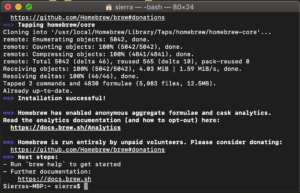To install Homebrew, open Terminal or your favorite OS X terminal emulator and run $ /bin/bash -c '$ (curl -fsSL The script will explain what changes it will make and prompt you before the installation begins. Localhost Binding by Default¶. By default, MongoDB launches with bindIp set to 127.0.0.1, which binds to the localhost network interface.This means that the mongod can only accept connections from clients that are running on the same machine. Remote clients will not be able to connect to the mongod, and the mongod will not be able to initialize a replica set unless this value is set to a. For the macOS platform, you can install the Azure CLI with homebrew package manager. Homebrew makes it easy to keep your installation of the CLI update to date. The CLI package has been tested on macOS versions 10.9 and later. The current version of the Azure CLI is 2.12.1. Install Homebrew (BREW) on Mac OS X Homebrew is a package management software, and it is free/open source on Mac OS X. Homebrew is written in Ruby Language. How to install latest version of openssl Mac OS X El Capitan. Ask Question Asked 4 years, 8 months ago. Active 3 months ago. Viewed 122k times 44. I have used brew install openssl to download and install openssl v1.0.2f, however, it comes back saying: A CA file has been bootstrapped using certificates from the system keychain.
Install Homebrew (BREW) on Mac OS X
Homebrew is a package management software, and it is free/open source on Mac OS X. Homebrew is written in Ruby Language. It is by default installed at /usr/local path. Ok, no need ‘bla bla bla…‘
ruby -e “$(curl -fsSL https://raw.githubusercontent.com/Homebrew/install/master/install)”
Uses of Homebrew
Using Homebrew we can install/uninstall or update the following software on Mac OS X. Not only this things, it’s more…
- Python
- Wget
- Eclipse
- PyDev
- Imagemagick
- Postgresql
- And so on…
How to use Homebrew for Install software?
It’s simple,
- brew install [software-keyword]

For Example, brew install postgresql

How to use Homebrew for Un-install software?
It’s Just,
- brew uninstall [software-keyword]
For Example, brew uninstall postgresql
How to use Homebrew for Upgrade software?
It’s Just,
- brew upgrade [software-keyword]
For Example, brew upgrade postgresql
Homebrew Cask which is an external command allowing installation of GUI applications, as well as “taps” dedicated to specific areas or programming languages like Homebrew PHP. For more
How to Install Homebrew (BREW) on Mac OS X?
The following two tabs change content below.- Step to Install JOOMLA in WAMP Localhost - March 30, 2020
- ‘Your Projects’ Links Not working in WAMP Server - March 29, 2020
The easiest way to install a number of Unix style applications and open source software onto macOS Catalina, Mojave and earlier Sierra OS versions is via a package manager, unfortunately, macOS Catalina doesn’t come with one, but fortunately, some good folks care, they come in the form of Homebrew.
The install of Homebrew also works on macOS Catalina, macOS Mojave, (High)Sierra, El Capitan, and Yosemite, so macOS 10.10 – 10.14
Homebrew isn’t the only option, also available is MacPorts and Fink but Homebrew is the newest and most popular of the trio.
Install Homebrew
To download install Homebrew run the install script on the command line as below and let the script do its thing:
If you don’t have Apples Xcode Command Line Tools installed it will prompt you to install to carry on with the Homebrew installation and download the Command Line Tools.
Then Homebrew is installed.
After this Homebrew is installed and ready to install other apps.
To get started run brew help can give some command example usage.
To check for any issues with the Homebrew install run:
One issue that typically comes up is an outdated or missing version of Xcode.
For the latest Catalina, brew doctor will warn that the Homebrew install won’t be 100% if Xcode is not up to date, so update Xcode from the App Store.
To search for an application:
To install
To list all apps installed by Homebrew
To remove an installed application
To update Homebrew itself
To see what packages are out of date but not to upgrade them
To see what upgrade packages all or singular
To hold a package at a certain version
To release a package from a certain version
To see what else you can do
Where does Homebrew install stuff …. in the Cellar
Where the brew lives.
You can see your Homebrew configuration by running

The output should be similar to …
Install Homebrew Mac Os Mojave
All installations via Homebrew are filed independently in the filing system in /usr/local/Cellar and linked into /usr/local/bin which is a directory which allows you to run these commands and apps as if part of the regular operating system.
This directory is also out of the SIP bounds so there should be no authentication macOS error dialog boxes.
Homebrew Install For Mac Os 10.10
Remove Home-brew and all packages
To remove the Home-brew installation and all packages it has installed..
Homebrew Install For Macos
HomeBrew is a great package manager just start installing some apps and explore.!